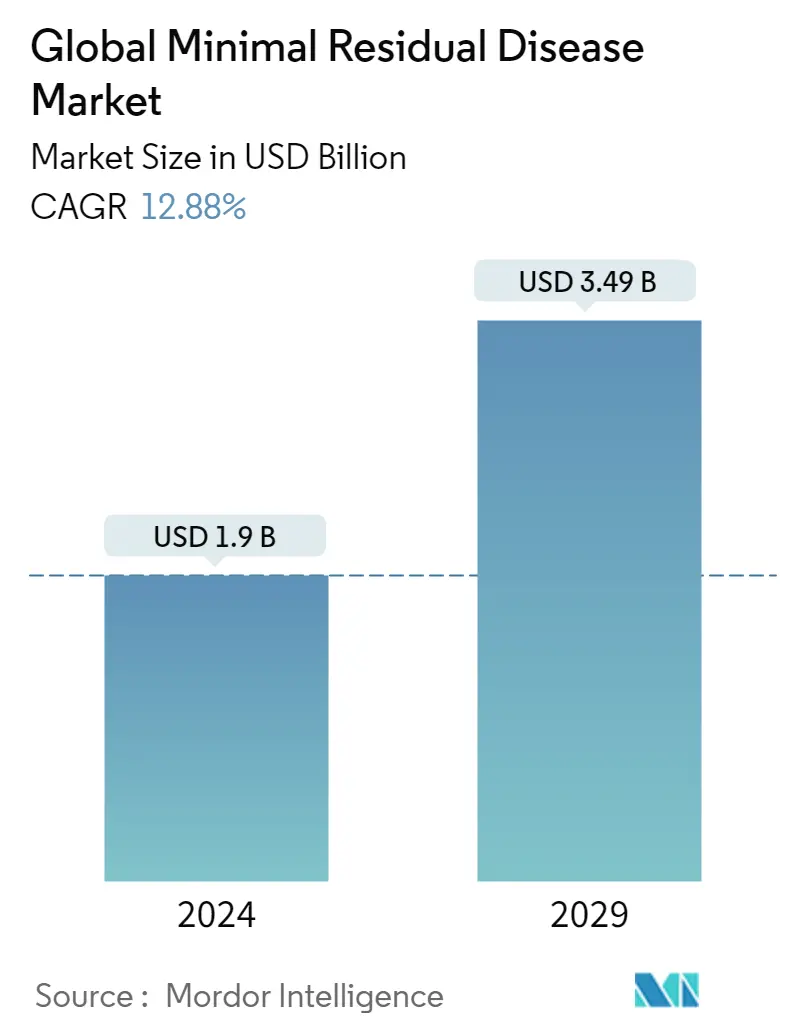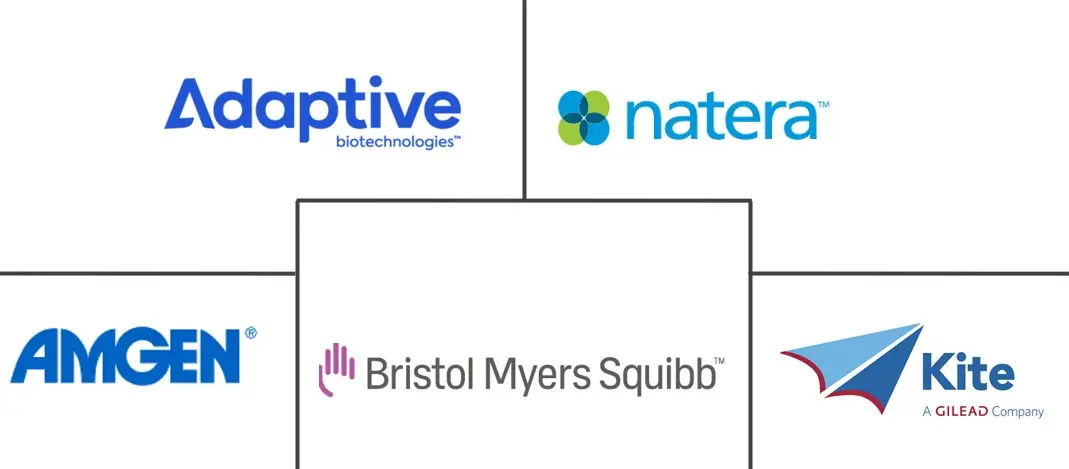Market Size of Global Minimal Residual Disease Industry

| Study Period | 2019 - 2029 |
| Market Size (2024) | USD 1.90 Billion |
| Market Size (2029) | USD 3.49 Billion |
| CAGR (2024 - 2029) | 12.88 % |
| Fastest Growing Market | Asia-Pacific |
| Largest Market | North America |
Major Players
*Disclaimer: Major Players sorted in no particular order |
Minimal Residual Disease Market Analysis
The Global Minimal Residual Disease Market size is estimated at USD 1.9 billion in 2024, and is expected to reach USD 3.49 billion by 2029, growing at a CAGR of 12.88% during the forecast period (2024-2029).
The COVID-19 pandemic affected healthcare systems globally and resulted in the interruption of usual care in many healthcare facilities, exposing vulnerable patients with cancer to significant risks. Since the beginning of the COVID-19 pandemic, measures have been taken to increase the admissions of covid patients and reduce the number of non-covid patients in the hospitals, leading to postponing the treatment. A study titled 'Impact of the COVID-19 Pandemic on Cancer Care: A Global Collaborative Study' in September 2020 reported that a total of 356 centers from 54 countries across six continents participated between April 21 and May 8, 2020. These centers serve 716,979 new patients with cancer a year. Most of them (88.2%) reported facing challenges in delivering care during the pandemic. Although 55.34% reduced services as part of a preemptive strategy, other common reasons included an overwhelmed system (19.94%), lack of personal protective equipment (19.10%), and staff shortage (17.98%), and restricted access to medications (9.83%). According to an article titled 'What is the Clinical Impact of COVID-19 on Cancer Patients?' in June 2020, the increased vulnerability of cancer patients to COVID-19, particularly to the severe effects of this infectious disease, has led some patients to delay or pause their anti-cancer treatments to reduce their exposure to potentially infected people, and this condition during initial pandemic phase affected the market adversely. Such studies indicate that cancer care was severely impacted, subsequently impacting the market growth. Hence, there is an overall negative impact of the COVID-19 pandemic on the market's growth.
The factors propelling the growth of the minimal residual disease market are the rising prevalence of various types of cancer worldwide and the increasing awareness among people to confirm the presence of carcinogens. The patients undergoing continued cancer treatment are expected to be the most important element driving the minimal residual disease market forward. In addition, the rising adoption of personalized medicines for the treatment and rising research and development activities contribute to the market's growth.
The increasing number of people suffering from various cancers is the key driving factor for the minimal residual disease market growth. For instance, as per the American Society of Clinical Oncology February 2021 report, an estimated 235,760 adults (119,100 men and 116,6600 women) in the United States were expected to be diagnosed with lung cancer. For instance, Globocan, 2020, it found that there are 18.3% new cases of cancers in India, and cervical cancer accounted for 9.4% of all cancers. For instance, according to statistics published by the American Cancer Society (ACS) updates from January 2022, approximately 26,560 new cases of stomach cancer are projected to be detected in the United States in 2021, with 16,160 males and 10,400 women. According to the statistics published by the National Breast Cancer Foundation, in July 2021, approximately 63% of breast cancer patients have been diagnosed with local-stage breast cancer, 27% with regional stage, and 6% with a distant (metastatic) disease.
In addition, the rising prevalence of blood cancer worldwide increases the demand for better treatment options and accuracy in removing the residual cancerous cells, which is likely to increase the demand for a minimal residual disease market. According to the statistics published by the American Cancer Society, in January 2022, 34,920 new cases of multiple myeloma were estimated to be diagnosed in the United States.
However, the high cost of research and development activities will likely hinder the market's growth over the forecast period.
Minimal Residual Disease Industry Segmentation
As per the scope of the report, the minimal residual disease is the presence of a small number of cancer cells in the body following therapy. These cells have the potential to recur in cancer patients and induce relapse. The Global Minimal Residual Disease Market is segmented by test technique (Polymerase Chain Reaction, Fluorescence In Situ Hybridization (FISH), and Next Generation Sequencing (NGS)), target detection (Leukemia, Lymphoma, Solid Tumors, and Others), by end-user (Hospitals, Laboratory centers, and Specialty Clinics) and geography (North America, Europe, Asia-Pacific, Middle-East and Africa, South America). The market report also covers the estimated market sizes and trends for 17 countries across major global regions. The report offers the value (USD million) for the above segments.
| By Test Technique | |
| Polymerase Chain Reaction | |
| Fluorescence In Situ Hybridization (FISH) | |
| Next Generation Sequencing (NGS) |
| By Detection Target | |
| Leukemia | |
| Lymphoma | |
| Solid Tumors | |
| Others |
| By End-user | |
| Hospitals | |
| Laboratory centers | |
| Specialty Clinics |
| Geography | |
| North America | |
| Europe | |
| Asia-Pacific | |
| Middle-East and Africa | |
| South America |
Global Minimal Residual Disease Market Size Summary
The minimal residual disease market is poised for significant growth, driven by the increasing prevalence of various cancers and the rising awareness of the need for accurate detection of residual cancerous cells. The market is expected to expand substantially over the forecast period, supported by advancements in personalized medicine and ongoing research and development activities. The COVID-19 pandemic initially disrupted cancer care, impacting market growth, but the subsequent recovery and the urgent need for effective cancer treatments have reignited market momentum. The adoption of next-generation sequencing technologies has further enhanced the market's prospects, offering greater sensitivity in detecting minimal residual disease compared to traditional methods. This technological advancement is particularly beneficial for monitoring acute myeloid leukemia and other cancers, facilitating early management and improving patient outcomes.
In North America, the market is experiencing robust growth due to the high incidence of hematological cancers and the region's established research infrastructure. Companies are increasingly focusing on developing innovative assays and tests to detect minimal residual disease, with significant investments in research and development. Collaborations and strategic partnerships, such as those between Adaptive Biotechnologies and GlaxoSmithKline, are enhancing the market's competitive landscape. Key players are actively working to improve treatment and detection methods, ensuring they maintain their positions in this highly competitive market. The ongoing development of next-generation sequencing platforms and liquid biopsy technologies is expected to drive further growth, as these innovations offer highly sensitive and specific variant detection capabilities, crucial for managing cancer recurrence and residual disease.
Global Minimal Residual Disease Market Size - Table of Contents
-
1. MARKET DYNAMICS
-
1.1 Market Overview
-
1.2 Market Drivers
-
1.2.1 Increasing Prevalence of Cancer
-
1.2.2 Increasing Investment in Research and Development
-
-
1.3 Market Restraints
-
1.3.1 High Cost of Research and Development Activities
-
-
1.4 Porter's Five Forces Analysis
-
1.4.1 Threat of New Entrants
-
1.4.2 Bargaining Power of Buyers/Consumers
-
1.4.3 Bargaining Power of Suppliers
-
1.4.4 Threat of Substitute Products
-
1.4.5 Intensity of Competitive Rivalry
-
-
-
2. MARKET SEGMENTATION (Market Size by Value - USD million)
-
2.1 By Test Technique
-
2.1.1 Polymerase Chain Reaction
-
2.1.2 Fluorescence In Situ Hybridization (FISH)
-
2.1.3 Next Generation Sequencing (NGS)
-
-
2.2 By Detection Target
-
2.2.1 Leukemia
-
2.2.2 Lymphoma
-
2.2.3 Solid Tumors
-
2.2.4 Others
-
-
2.3 By End-user
-
2.3.1 Hospitals
-
2.3.2 Laboratory centers
-
2.3.3 Specialty Clinics
-
-
2.4 Geography
-
2.4.1 North America
-
2.4.2 Europe
-
2.4.3 Asia-Pacific
-
2.4.4 Middle-East and Africa
-
2.4.5 South America
-
-
Global Minimal Residual Disease Market Size FAQs
How big is the Global Minimal Residual Disease Market?
The Global Minimal Residual Disease Market size is expected to reach USD 1.90 billion in 2024 and grow at a CAGR of 12.88% to reach USD 3.49 billion by 2029.
What is the current Global Minimal Residual Disease Market size?
In 2024, the Global Minimal Residual Disease Market size is expected to reach USD 1.90 billion.

